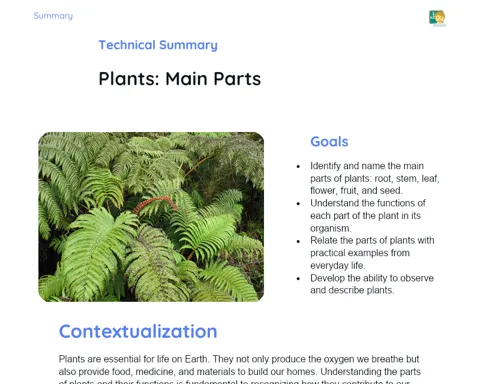Introduction
Rock Types: The Construction of the Planet in the Palm of Our Hands
Rocks are the raw material for the construction of our geological history. They are essential to understand the formation of planet Earth, shaped by natural processes that occur over millions of years.
Igneous, sedimentary, and metamorphic rocks, the three main types of rocks, represent silent witnesses of the dynamics of our planet. They reveal to us the cosmic symphony that is Earth - an intricate, but harmonious, balance of temperature, pressure, and time that gives rise to the vastness and diversity of rocks that have been forming the Earth's crust over the last 4.6 billion years.
Look around you - from majestic mountains to the plebeian laughter of cobblestones, we, you and I, interact daily with these geological wonders. Let's explore together what they have to tell us!
Theoretical Development
Components
-
Igneous Rocks: These are rocks formed by the solidification of magma (inside the Earth) or lava (on the surface). They are at the base of the rock formation pyramid, being the "first children" of the planet's interior. Examples of these rocks include granite, basalt, and pumice.
-
Sedimentary Rocks: Resulting from the accumulation and compaction of sediments (sand, gravel, silt) over time. They provide us with a "geological chronology" of the events that occurred. Their name says a lot: sedimentary, as they are rocks that 'sit' over time. Examples include sandstone, limestone, and conglomerate.
-
Metamorphic Rocks: These are rocks that have undergone a physical and/or chemical transformation due to high temperatures and/or pressures inside the Earth. They are considered the "rocks of change", as they had their structures and compositions altered. Examples include gneiss, slate, and marble.
Key Terms
-
Magma: A semi-fluid mass formed by melted minerals and gases, present inside the Earth.
-
Lava: The magma expelled on the Earth's surface.
-
Sedimentation: The process in which sediments are deposited, separated, or accumulated.
-
Compaction: The process by which the pressure of overlying sediments causes the space between the grains to decrease, resulting in solid rock.
-
Metamorphism: Processes that occur inside the Earth and alter the composition and/or structure of a rock, without it becoming a liquid or a gas.
Examples and Cases
-
Granite: A wonderful example of igneous rock that is widely used in civil construction due to its resistance and durability. Its characteristics, such as color and texture, can vary depending on the minerals present.
-
Sandstone: A sedimentary rock formed by the compaction of sand grains. The layers and granulation of the rock can tell the story of the region where it was formed, such as ancient deserts or beaches.
-
Marble: Previously limestone, it transformed into metamorphic rock after undergoing metamorphism. Its beauty and use in sculptures and historic constructions, like the Taj Mahal in India, are witnesses to its history on Earth.
Detailed Summary
Relevant Points
-
Nature and Formation of Rocks: Rocks are formed and altered by geological processes that operate over millions of years, resulting in three main types: igneous, sedimentary, and metamorphic.
-
Igneous Rocks: They originate from magma, a liquid compound of minerals and gases, solid or melting, present underground. The solidification of magma originates intrusive igneous rocks, like granite, when it occurs in depth, and extrusive igneous rocks, like basalt, when it occurs on the Earth's surface.
-
Sedimentary Rocks: They originate from the fragmentation and erosion of other rocks, followed by the transport, deposition, and compaction of sediments. The conditions of this process can be identified through the sedimentary layers, as in the case of sandstone.
-
Metamorphic Rocks: Originated from the transformation of other rocks under conditions of high temperature and/or pressure, they have a distinct crystalline structure and often exhibit "bands" or "folds" that indicate the changes they have undergone.
-
Main Terms: Magma, lava, sedimentation, compaction, and metamorphism are fundamental terms for understanding the formation of rocks and the geological context.
-
Examples of Rocks and Their Uses: The analysis of rocks like granite (igneous rock), sandstone (sedimentary rock), and marble (metamorphic rock) allows a practical understanding of their characteristics and applications in our daily lives.
Conclusions
-
Rock Cycle: Rocks are in a constant process of transformation on Earth, migrating from one type to another in a continuous cycle known as the rock cycle.
-
Influence of Rocks: The characteristics of rocks directly influence the formation of landscapes, the determination of biodiversity, and even the definition of soil types.
-
Silent Reading of the Earth: The observation and study of rocks provide us with valuable information about the history of our planet, revealing past and present geological events.
Suggested Exercises
-
Identification of Rocks: Conduct a local search and identify examples of igneous, sedimentary, and metamorphic rocks in your region. Provide a detailed description of their physical aspects (texture, color, mineral composition).
-
Formation Processes: Explain, in your own words, how igneous, sedimentary, and metamorphic rocks are formed. Use the key terms from the lesson to support your answers.
-
Applications of Rocks: Make a list of the main applications of igneous, sedimentary, and metamorphic rocks in our daily lives. Justify your choices.



